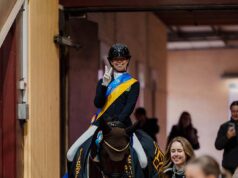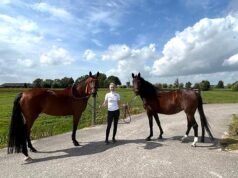Analysis by Adriana van Tilburg: There are so many events, decisions and sometimes uncontrollable circumstances that shape the path of a horse’s career, and all must be carefully managed to ensure a high level of success. One of the first decisions in a horse’s life involves the selection of a breeding pair, with careful choices based on the talents and personality of both stallion and mare.
A horse is most impressionable in its early years, and its education during this phase, is critical to the development of a stable and well- adjusted animal. Erin Characklis (48) has built a reputation for discovering young, talented horses and developing them into successful competitors at the highest levels of showjumping. Zeremonie was one of Erin’s ‘students’. Bred by Hans Joachim Ahsbahs, Zer- emonie (Cero I - Toulouse x Quickstar, stamm 275), came to Characklis as a five- year-old and was later sold to Laura Kraut (USA). This horse went on to qualify for the 2016 Rio Olympic Games as the reser ve member of team USA. In 2017 she was declared best horse of the Aachen CHIO after jumping double clear in the Nations’ Cup and placing fourth in the Rolex Grand Prix. Other notable horses trained and shown by Characklis include Carolina (2017 World Cup Final), Clouwni (Caen 2014 world championships), and Wunschkind (currently competing under the saddle of Eric van der Vleuten). In all of these cases, it is Characklis’s eye for talent, unique training methods and patient development of these horses that has led each to extraordinary success.
We had a chance to meet with Erin recently and talk with her about her personal journey and approach to training successful young horses.
Q What made you decide to come to Europe?
It was actually a string of events that initially brought me to Europe 25 years ago (1993) and a number of factors that led to me staying here. When I first arrived I met Hans Horn through a mutual friend and was lucky enough to be able to work with him at his ‘de Wiemselbach’ stable in Ootmarsum. This was a very exciting as Hans was chef d’equipe of the Dutch Olympic team at that time. In addition, Jos Lansink was just coming off his Olympic medal winning performance in Barcelona (1992) and had a number of ver y talented horses. So, these first experiences in the European system were exceptional, and contributed to inspiring me to stay and make a go of it.
Q What was it like working at de Wiemselbach?
De Wiemselbach was, and still is, one of the most well managed operations that I have had the pleasure of working in, and at the time I was very fortunate to have the opportunity to work with many top horses. A few par- ticular examples include, Libero H (Landgraf I - Octave x Ronald, stamm 2830, bred by Martin Röpke) at the peak of his career, Easy Jumper (Eiger I - Amour x Absatz, bred by Albert Knödgen) who was competing at the highest levels during that time, and Lux Z (Lord Calando - Apocalypte Z x Ahorn Z, stamm 2543, bred by Maas J. Hell), a six-year-old that was already showing great potential. This was also my first introduction to the aware of the importance that quality breeding pro- grams have on the industry. This led to my continuing interest in bloodlines and their influence on the performance of young horses, knowledge that I put into practice every day in my own stable. To this day, the presence of Libero H in the pedigree of a young prospect will always spark my interest. My interest comes from knowing Libero H, by spending time with him as an individual daily. That creates a more person- al feeling toward the line and its offspring.
Q How did you end up in Holstein?
I moved to Holstein in 1995 because of a job opportunity there. Later I found that being near the center of where most Holsteiners are bred and raised gives one a good advantage when it comes to searching for and discovering young talented prospects. The advantages of being located in Holstein mostly come down to being well informed. There are numerous events taking place all within a driving radius of about 200 kilometres that are focused primarily on developing the Holsteiner breed. Therefore by living in the middle of this breeding area there are numerous opportunities to discover young horses that are for sale or to market your own horses...
SUBSCRIBERS CAN READ THE COMPLETE ARTICLE IN THE CURRENT EDITION OF BREEDING NEWS.



